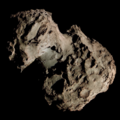 Comet Nishimura photographed from Trevinca, Spain on 25 August 2023 | |
| Discovery [1] | |
|---|---|
| Discovered by | Hideo Nishimura |
| Discovery site | Kakegawa, Japan |
| Discovery date | 12 August 2023 |
| Designations | |
| HN00003 | |
| Orbital characteristics [2] [3] | |
| Epoch | 8 September 2023 (JD 2460195.5) |
| Observation arc | 495 days (1.36 years) |
| Earliest precovery date | 19 January 2023 |
| Number of observations | 638 |
| Aphelion | 114 AU (1800) 109 AU (2200) [4] |
| Perihelion | 0.2252 AU |
| Semi-major axis | 58 AU |
| Eccentricity | 0.9961 (1800) 0.9959 (2200) |
| Orbital period | ≈433 years (inbound) ≈406 years (outbound) |
| Max. orbital speed | 88.7 km/s [5] |
| Inclination | 132.48° |
| 66.834° | |
| Argument of periapsis | 116.30° |
| Last perihelion | 17 September 2023 [5] [3] ≈1588–1592 [6] [2] |
| Next perihelion | ≈2429 [7] |
| TJupiter | –0.307 |
| Earth MOID | 0.079 AU |
| Jupiter MOID | 2.328 AU |
| Physical characteristics [3] | |
| Comet total magnitude (M1) | 12.2 |
| 2.5 (2023 apparition) | |
C/2023 P1 (Nishimura) is a long-period comet discovered by Hideo Nishimura on 12 August 2023. [8] The comet passed perihelion on 17 September 2023 and reached an apparent magnitude of about 2.5. [9]








